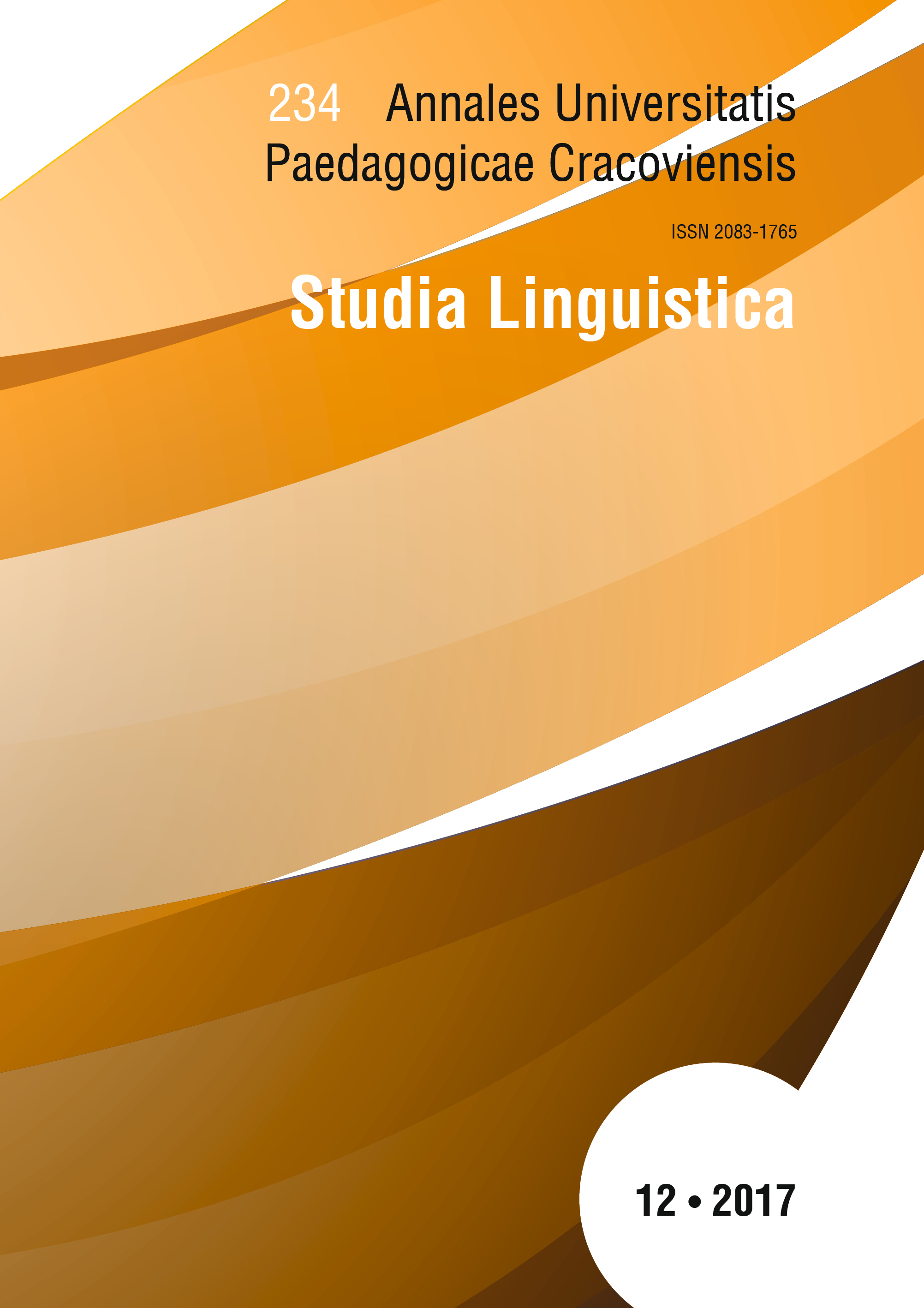Does Słownik staropolski (The Old Polish Dictionary) need defence?
Main Article Content
Abstract
The author presents a scientific methodology of a linguist - historian who works on vocabulary of the oldest, manuscript era of Polish language. Here are some examples of problems that need to be addressed by the author of the dictionary headword and attempts to solve them. The author argues that it is only on the basis of Old Polish dictionary that further research on Old Polish language can be based.
Downloads
Article Details
Author, submitting a text to the editorial board of the journal “Annales Universitatis Paedagogicae Cracoviensis. Studia Linguistica", certifies that the content of the article has not been published so far and that the work does not violate in any way the copyright or related rights of other person, as well as other rights of third parties, and that no one's rights to the work (or any part thereof) have been missed. After signing the contract, the property rights to the published materials are transferred to the Scientific Publisher of the University of the National Education Commission, Krakow.
“Annales Universitatis Paedagogicae Cracoviensis. Studia Linguistica” is an open access journal, and all its content is made available free of charge to users and institutions under the Creative Commons CC-BY-NC-ND 4.0 license (attribution, non-commercial use, no derivative works). Under this license, the authors agree that their work may be lawfully reused for any purpose, except for commercial purposes, without the prior consent of the author or publisher. Everyone can read, download, copy, print, distribute and process these works, provided that the author's marking and the original publication place are correct. Published texts may not be used to create derivative works (e.g. to translate and publish in another language without the consent of the publisher). This is in line with the BOAI (Budapest Open Access Initiative) definition. "Studia Linguistica" does not charge for submitting or processing articles.
References
Bělič J., Kamiš A., Kučera K., 1978, Malý staročeský slovník, Praha.
Google Scholar
Deptuchowa E., 2009, Leksemy z przedrostkowym z- w Słowniku staropolskim, „Biuletyn PTJ” LXV, s. 201–214.
Google Scholar
Deptuchowa E., Wanicowa Z., 2010, Tajemnice staropolskich glos, „LingVaria” V/II, s. 105–111.
Google Scholar
Deptuchowa E., Frodyma M., Szelachowska-Winiarzowa L., Wanicowa Z., Wysocka F., 2014, Skarbnica leksyki staropolskiej, „Język Polski” XCIV, s. 250–264.
Google Scholar
Frodyma M., 2017, Z doświadczeń w pracy nad Suplementem (cz. I) do Słownika staropolskiego, „W kręgu dawnej polszczyzny”, red. M. Mączyński, E. Horyń, E. Zmuda, t. IV, s. 11–22.
Google Scholar
Łoś J., 1922, Bogurodzica, pierwszy polski hymn narodowy, Lublin.
Google Scholar
Mazurkiewicz R., Wanicowa Z., 2005, Dlaczego Bogurodzicę śpiewano w okresie liturgicznym Bożego Narodzenia? „Pamiętnik Literacki” XCVI, s. 25–41.
Google Scholar
Mika T., 2012, Kazania świętokrzyskie – od rękopisu do zrozumienia tekstu, Poznań.
Google Scholar
Nazwy miejscowe Polski, 1997, red. K. Rymut, t. II, s. 409, Kraków.
Google Scholar
Słownik polszczyzny XVI wieku, od 1966, red. M.R. Mayenowa, K. Mrowcewicz, Wrocław– Warszawa.
Google Scholar
Słownik łaciny średniowiecznej w Polsce, od 1953, red. M. Plezia, K. Weyssenhoff-Brożkowa, M. Rzepiela, Wrocław–Kraków.
Google Scholar
Słownik staropolski, 1953–2002, red. St. Urbańczyk, t. I–XI, Wrocław–Warszawa–Kraków.
Google Scholar
Szelachowska-Winiarzowa L., 2010, Historia jednego hasła w Słowniku staropolskim (korzaciec), „Język Polski”, XC, s. 91–98.
Google Scholar
Szelachowska-Winiarzowa L., 2014, Co staropolszczyzna zawdzięcza królowi Władysławowi Jagielle?, „Język Polski” XCIV, s. 273–289.
Google Scholar
Szelachowska-Winiarzowa L., 2014, Ulotne interpretacje, wieczne zapisy. Doświadczenia leksykografa przy opracowywaniu nazw przyrodniczych do suplementu Słownika staropolskiego, „LingVaria” IX/2, s. 271–280.
Google Scholar
Twardzik W., 2009, Jak właściwie rozumieć niewłaściwie dotąd rozumiane ostatnie cztery zwrotki staropolskiej pieśni Maryja czysta dziewice, „Teksty Drugie”/3, Warszawa, s. 234–244.
Google Scholar
Twardzik W., 2010, Kamień, który odrzucili budując, czyli o staropolskich imiesłowach nieodmiennych w funkcji podmiotu (wraz z Iwanem Petrovem), „Język Polski” XC, s. 5–15.
Google Scholar
Wanicowa Z., 2009, Ignota, dubia, reperta. Czytać i rozumieć staropolszczyznę, Kraków.
Google Scholar
Wanicowa Z., 2010, Na marginesie prac nad suplementem do Słownika staropolskiego, „Język Polski” XC, s. 16–22.
Google Scholar
Wanicowa Z., 2017, Współcześni Polacy a percepcja języka staropolskiego, „W kręgu dawnej polszczyzny”, red. M. Mączyński, E. Horyń, E. Zmuda, t. IV, s. 97–104.
Google Scholar
Bibliografia internetowa prac członków zespołu redagującego Słownik staropolski https://pjs.ijp.pan.pl/bsstp.html (dostęp: 16.06.2017).
Google Scholar
